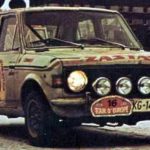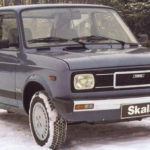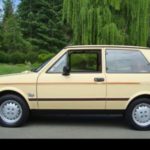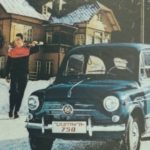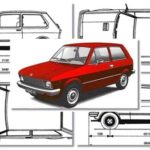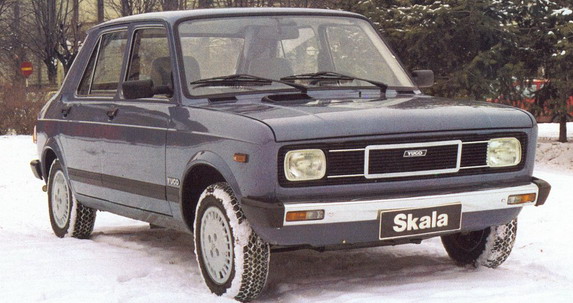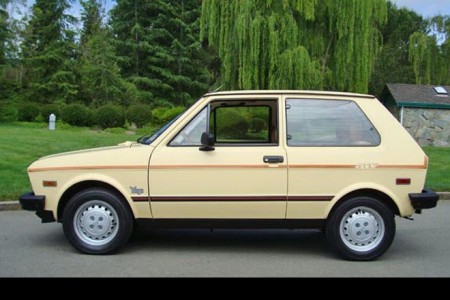Flag 101 - 100 woes of the legendary Stojadin
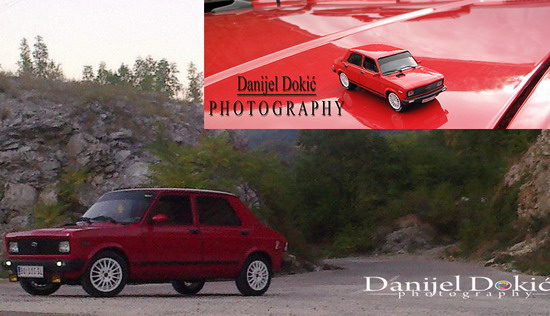
Zastava 101
Of all the cars that drive in the former SFRY, Zastava The 101 is a car that is always characterized by two extremes. One group of drivers does not want to give up their Stojadin and keep their car in constant operation, while another group declares Stojadin to be the "worst car in the world" and only drive it because of various economic, most economic reasons. must.
In this article, the history of the Flag 101 will be briefly systematized from the beginning, through the end, to the new beginning and the gradual creation of a car legend that lives not only in our area, but in the world. The complete article is based on the testimonies of all those who shared their memories with the members of the Flag 101 Club.
How did Flag 101 come about?
History of "Zastava NV" (National Vehicle), as it was written in 1970 by Fr. Flags 101, began in Turin in 1967, when Dante Giakosa, in collaboration with the design house Boano, developed the idea of a hatchback version of the Fiat 128, under the designation Fiat 128 B1. This model was too ahead of its time for FIAT and the project remained at the level of initial development until the visit of Zastava's delegation led by the legendary Prvoslav Raković in 1969. Although our delegation was counting on a license for Fiat 124 to enrich and modernize Zastava's offer, the side of the Fiat delegation was amazing, the license for the Fiat 128 hatchback, the most modern car of its class in Europe. In the same year, the creation of a legend began, which would later be christened as Flag 101 with the first nickname "unit". When the FIAT 128 was named Car of the Year, in 1969, the first information about Zastava's new vehicle began to warm up the Yugoslav public. The following year, the Slovenian "Auto-magazine" published the first photographs, and Zastava salons in larger cities in Yugoslavia received prototypes. The hysteria has begun and waiting lists have been formed. The following 1971, pre-series production began, and at the end of 1971 and the beginning of 1972, when the new factory in Kragujevac was completed, serial production began.
Who drove all the Flag 101?
From the very beginning, Flag 101 has attracted the attention of the public figures of the SFRY and has been owned by a large number of actors and singers. Famous athletes were also buying Flag 101, and the Red Star football club was buying red and white Stojadins for their players. Rally sports stars such as Branimir Peric Joe, Branko Nadj and Jovica Palikovic even competed with their Stojadins. JNA officers also respected the domestic product and for their own family car they ordered the Flag 101, most often in gray-olive, military color, which was later included in the factory color palette under the SMB code.
An interesting piece of information is the Museum of the History of Yugoslavia: in 1976 a special model of the Zastava 101 Lux was prepared, with richer equipment and an engine of 1300 cubic meters, which was personally donated by SFRY President Josip Broz Tito to USSR President Leonid Brezhnev. Leonid Brezhnev was known as a car lover and was pleased to include our Stoyadin in his collection. This event is evidenced by several photographs, available in the archives of the Museum of the History of Yugoslavia.
The time of affordable loans has made it possible, although expensive, for Flag 101 to be available to a growing number of families. A limited number of vehicles were available in showrooms, so long waiting lists were formed. Although it was an expensive car, in the 101s there was no excess of Flag XNUMX on the motorways. A special six-month waiting system has been created. At the end of the period and the payment made, a telegram arrived and the future owners had three days to find a vehicle in one of the showrooms. Well, there are known stories of waiting outside the salon at four in the morning and picking up the car at night under the flashlight. Who failed to pick a car in three days was returning to the bottom of the waiting list. As the older generations describe, the days on the motorways were flat hysterics even with the occasional incident (it happened that people got beat up because they couldn't agree on what the car first chose).
Flag 101 Abroad?
Although our automotive public does not want to admit it, Zastava 101 was a brand and a successful car in its time. Due to the fact that Zastava 101 was also sold within the FIAT sales network, there was a high demand in European countries such as France, Germany, Great Britain, but also in the countries of the former Eastern bloc. In Czechoslovakia, Flag 101 was a status symbol, not everyone could afford it, and whoever had it had to be a person of special importance. The demand was so great that Kragujevac-based Zastava could not even produce enough vehicles for export. On the basis of bilateral agreements on trade between the Red Flag Institute and the Warsaw FSO, the production of Zastava 101 began in Poland, under the designation Zastava 1100P (1973-1982). Exports also flourished in other countries such as Egypt, Argentina, the USSR, Chile, Hungary and many others.
According to research conducted by Zastava 101 Club, our Stojadin became a legendary car in Poland before our automobile public recognized Stojadin as a vehicle of historic importance. There are several enthusiast clubs that have restored their makeup and makeup to their factory glory.
How did Stojadin become part of the family?
The time when Zastava 101 appeared was another time, difficult for the younger generation to understand. The scars of World War II were still present, and the world was changing rapidly. The enthusiasm for the economic, industrial and cultural development of Yugoslavia was still going on. American music had a great influence and rock and roll culture was at its peak. The wardrobe changed. The style of furniture, technical devices were extremely expensive and every appliance was respected. People hung out a lot more because they didn’t have easily accessible electronic media to keep them in the house. Television was often watched in the company of several families with one of the neighbors because not everyone could afford a TV set. Music devices from domestic producers were somewhat more accessible, so that each household had a Nis, Ei radio with a milieu and a room antenna, in a visible place in the household.
The cars were really part of the family back then. For years, it has been spared the most common vehicle in Yugoslavia, the Flag 750 - the famous Fic. And then Flag 101 appeared. Most families wanted it, and most could raise a loan to buy it. The parking lots were gradually filling up with Stojadins, and by then the ritual of washing cars on weekends, in front of a building or on the promenades by the rivers became more frequent and more pronounced - everyone wanted to boast about their Stojadin. Car washing was a family activity, the whole family took part and we can say it was a real trip when even the barbecue was burning. A new decade of camaraderie has begun. Scenes in wide parking lots were common: several Flag 101s at a short distance around which crowds gathered to fix or improve something on the car. Amateur motor hair styling, refinishing of lighting systems, installation of fog lights, and other equipment that could not be obtained with Stojadin are beginning. At the time, auto shops were selling special parts specific to just one car model, but not everything was easily accessible in one place. Current was the "hunting" of parts throughout the city. So the rubber mats that were specially made for the Zastava 101 were made by the tire factory '' Sava '' from Kranj, the air diffusers for the bonnet grilles worked by '' Jugoplastika '', the masks for the installation of radios made by '' Tehnika '' from The towers or fog lights manufactured by '' Saturnus '' from Ljubljana could be found on different sides of the world in the city or even had to go to larger cities for these parts to be found. The most common stores were 'Zastava promet', 'Auto-Sumadija', 'Auto-Jagodina'.
Family trips to Trieste were becoming more frequent as parts of the FIAT 128, which were not available in Yugoslavia, could be installed on the shopping list for wardrobes and home appliances, and could be fitted to Stojadin.
A summer vacation in an Adria caravan was a common arrangement for a certain group of drivers. The first problems immediately appeared. The lack of visibility of the traffic behind the trailer was the biggest problem, because the small rear-view mirror could not satisfy the needs. Increasingly, it was possible to buy additional brackets that were attached to the front wings with butterfly clamps, and at the top was the famous HTD (factory "Hero Toza Dragović" from Ohrid), a chrome mirror. Another big problem was the significantly increased fuel consumption, and then the thoughts turned to aerodynamics. Drivers are starting to make the first roof spoilers, and the team of the magazine "SAM" is conducting serious research in the early eighties and publishing the results with precise instructions for making spoilers. There were not uncommon scenes on the roads where a trailer with a sailboat, dinghy or even a speedboat was attached to the hook of the Zastava 101.
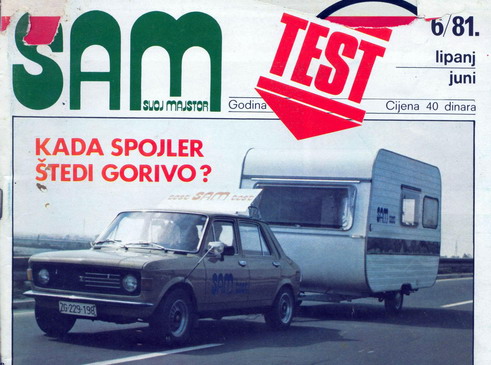
The competition for drivers who will have a better and more prestigious car Hi Fi has begun. The speakers began to fit into the front and rear door trims to get the best possible sound. The radio with automatic release of the other side of the audio cassette was a real luxury and, despite the high price, it was very difficult to find. Domestic manufacturers could not keep up with the trend, so the 'smuggling' of Philips and Pioneer systems was the most common, and the popular Orion, which came in a two-speaker set, costing as much as $ 1979 in 290 dollars.
Flag 101 starts to get names, ie. nicknames. Due to poor finishing during production conquest, the first series had a lot of problems, so the nickname '' unit '' was replaced by the more common, Sumadian name Stojadin (Sto jada). This name was common in Serbia, Croatia, Bosnia. In Belgrade he was often christened as '' Kec '', in Slovenia as '' Stoenka '', and in Macedonia as '' Stojdza ''.
On the other hand, in comparison to older cars, the modern Zastava 101 increased the tourist traffic in the country, but also abroad because Stojadin with modern engine solutions was a far more reliable car, providing both greater comfort and significantly higher cruising speed.
Motorists' "hunting stories" caught the eye. Constant proof was present on the roads. The car was traveling faster, faster, shortening travel time. Highway racing stories have been constant. The drivers of the Flag 101 have always liked to brag about going at speeds in excess of 160 km / h - the highest number on the speedometer. With the advent of the Flag 101 Special, 1979 - the strongest Stojadin with 1300ccm engine and 73 hp the stories became even more interesting. So motorists started weighing up with much stronger and bigger cars. This cult model was equipped with instruments from the FIATa 128 Rally, so it had an integrated torque meter in the right segment, the speedometer was showing up to 180 km / ha instead of the pixel it had engine temperature and oil pressure indicators.
The modern age of consumer economics has brought us an easily accessible car that has transformed from a street wonder into the most ordinary apparatus that moves us from one place to another. The former wide variety of bright, cheerful and noticeable colors has been replaced by the three most common colors: white, black and metallic gray, there are other shades but these are mostly gloomy, dark shades. It used to drive to feel adventure, enjoyment, not in a hurry, and when it was in a hurry, again the experience was far different. Flag 101 was, in its day, really part of the family. The owners were aware of the value of the car, but not only the material, but the more beautiful, the feeling of freedom and attachment to the machine.
Stojadin has always been there for its owners, present in all walks of life. During our teenage days, our fathers used to know that they '' steal '' their father's car in order to drive on streets where there was no traffic control.
The driving test meant a step towards adolescence and independence, so often the 'red' was obtained or earned, stored for fueling at 'Jugopetrol' or 'Ina' pumps. The boys with the car had the advantage over the girls, so the romance of the teenage days was associated with listening to quiet music over romantic landscapes and again in the seats of the Flag 101. On the other hand, the girls who had Stojadin at their disposal always attracted more attention, especially if Stojadin was a model Super or Special, and the driving skill of a sports character; that detail was becoming a major side-effect in the eyes of men. November days of generations of our fathers tied Stojadin to the celebration of the passed exams by buying gramophone records in "Jugoton", in the vicinity of which parking was difficult to find. Individuals used Flag 101 to elaborate their final work on the advancement of various automotive systems. Some even found rhetoric lessons inspired to speak precisely in the concept of a national vehicle.
Going into the army was a crucial act in the life of the old generation, then life used to change completely. Motorists almost without exception have a photo next to their car, in a formal uniform. After finding a job, a certain group of drivers went to work every day in their car, and taxi drivers earned their salary with Zastava 101. The lucky ones who received apartments from the company remember moving things and comment with a smile on how much Stojadin could load. And during the political and economic crises, Stojadin was there for the survival of entire families to depend on his cargo abilities, most often related to trade or rough work.
Verification was also an important act, so drivers could cheer by recording an audio cassette so that at a certain point, a song would start to ask a fateful question and a wedding ring would be handed over. At Stoadin's wedding, there was a tricolor, the famous two-tone siren drawing attention to the wedding party. All film arrangements for weddings were used, from running out of church or municipality to Stojadin, going full throttle on a wedding trip, through cans tied to the rear bumper, and to some extent he was able to change his mind and escape the wedding with gas too. to the floor. Some drivers like to brag that the Flag 101 also served as their "love apartment" for spending time with their spouse or mistress, and some more interesting "hunting stories" can be heard. It is interesting to note that Zastava services had many complaints about the introduction of new front seats with a reclining backrest, the cracking of the seat-lowering mechanism, so motorists with such a breakdown were often in trouble because speculation as to why the mechanism of the crack was very picturesque and they knew far away to be heard.
The births of the child were also related to Stojadin, from the moment when the expectant mother is taken to the maternity ward to the moment when the happy father breaks open the car door either on the way to see his child or as he tells relatives. The moment of bringing a newborn home is often immortalized by photography, and very often there is a car somewhere in the shot. The development of the child was accompanied by photographs along with Flag 101 for a variety of reasons: from family trips, to the simplest child's play that had to be immortalized because it disturbed the hearts of parents.
Retirement days employ Flags 101 for a well-deserved vacation, various forms of recreation such as hunting or fishing, trips to spa resorts, or for occasional "playing" in the parking lot. Many old motorists who have lost their driving license still preserve their cars as memories of past times, most often imbued with fond memories.
On the other hand, Flag 101 also mourned and wept in secret. Stojadin also followed the fate of families and people. Many, thanks to Stojadin, were able to escape from various disasters, either natural or caused by human recklessness (in every sense) and thus save themselves and their family. Behind the wheel of this car, many have also ended their lives, both from old age, illness, and in road accidents where it was no longer necessary to look for the culprit before the law. The attachment of individuals to this car can be seen on the individual tombstones bearing the image of the person next to their Flag 101.
Flag 101 building a house?
In addition to the parade and tourist role in Yugoslav families, Stojadin had a working role. Thanks to the five doors with a large opening angle and the rear seats fold down, the boot volume increased to 1010 liters. Fadip from Bečej produced a roof rack with a payload of up to 50 kg, specially manufactured for the Flag 101. We also offered tow hooks from the same manufacturer, which were attached to the reinforcement under the rear seats. The full cross-section roller iron combined the aforementioned reinforcement with the reinforcement for towing a damaged vehicle - the rear bumper brackets, which were connected by strong iron, with a standardized hook in the middle. Load capacity according to factory specifications was 400 kg. The 'Fadip' hooks will remain remembered for the scattered tennis balls used by riders to protect the hook ball from atmospheric influences. The "101 Adria" campsite and cargo trailers were most commonly seen on the Zastava XNUMX towbar.
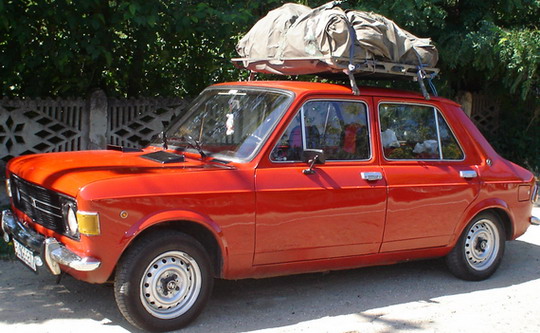
Since it immediately proved that Stojadin was sufficient to carry out work on cottages and houses, from the early days Stojadin got a job in the economy and agriculture. Although the Zastava 1984 T - Poly truck was manufactured in 101, manufactured at the Zastava Special Cars factory in Sombor, passenger Stojadins continued to carry serious cargo throughout the former Yugoslavia. That's when the saying '' A car is not a car unless it built at least a cottage '' was created. The loads became heavier, the maximum payloads increased, and the Stoadins were increasingly so loaded that the back movements began to correct under the weight, so the services of blacksmith workshops became more and more demanded. This trend of exploitation of Stojadin results in a large number of Zastava 101 from the "golden decade" completely disappearing from the streets.
The need for additional trap reinforcements is becoming increasingly real. On the expeditions of Zastava 101, the development of trap reinforcement began. Zastava blacksmiths have started pre-series production of the so-called sled - a flat iron that connects the balance bar bracket and the welded bracket on the oscillating shoulder bearing. The sledge was tested for the first time in the difficult conditions of the Kragujevac - Kilimanjaro expedition and proved to be an extremely effective additional part. The cargo experiences of consumers have shown that Stojadin's body is not omnipotent and that over time it starts to shoot at the front baskets. There is also the phenomenon that the front shock absorber brackets start to shrink towards the engine compartment, and as a consequence, the symmetry of the front trap occurs, which reduces handling and stability, and the tires are more susceptible to wear. The sledges entered serial production for the needs of Zastava 101 T and official vehicles intended for the militia, the army and medical institutions. There is no exact information when the first sledges were serially installed on the mentioned Stojadine, but it is assumed that this happened only in the early eighties. Although extremely sought after as an accessory, sledges became available to the general public only in the early 101s, thanks to the small blacksmith company "Felna" from Belgrade, which continues to produce reinforcements for all types of cars. The experts of this company made a radical change in the way the sled was attached: there was no longer a need to weld an additional support to the oscillating shoulder bearing, but a screw that fastened the oscillating shoulder to the body took over the role of the support. "Felna" received a Certificate from the Vinca Institute for Motor Vehicles. Tests have shown that the "Felna" sled increased the safety of the Zastava XNUMX in the event of a head-on collision, but also took over the absorption of heavy stresses of the lower system that lead to the jump of the drive axles from the differential. The engineering works of this company did not stop at the sledge.
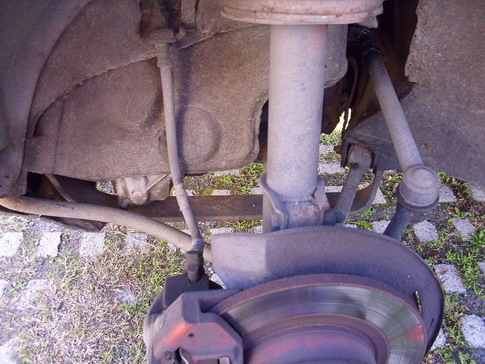
Soon they become accessible and traversed, in the sporting world of Stojadin known as the 'hair'. The role of this part is to prevent the front wheels from shrinking toward the engine. This part was never fitted as standard, but was well developed for the needs of Zastava 101 Reli - styled Stoadins for racing that never officially went into series production, but many were made, almost by the same model, both in Zastava Sport and individual workshops. The "hair" was always made of a steel disc that relied on the front shock absorber mounts, and a hollow tube was welded to the discs, which had torsional capabilities but with low deformation rates. The biggest disadvantage of the "hair" was the fact that the spare wheel could no longer fit in the factory bay in the engine compartment. As early as the mid-XNUMXs, the Felna marketed a more practical traverse with a curve that allows for the placement of a spare wheel. The flight attendants immediately came up with the shorter name: '' crooked hair ''.
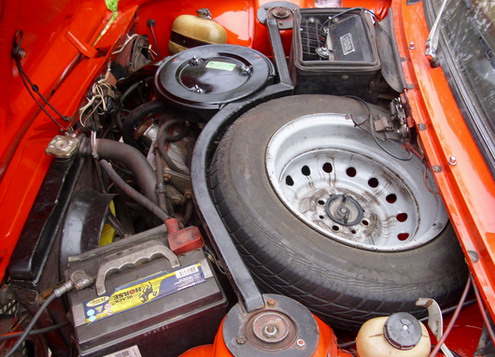
The biggest disadvantage of the 'curly hair' is that it prevents the air filter housing from being fitted to the dual-carb carburetor, but among the Stojadin series drivers, this part has become an absolute sensation. Although already a road veteran, Stojadin continues to be exploited to maximum loads in the 21st century. At the beginning of the XNUMXs, the Felna team launched additional rear axle springs on the market, the role of which is to increase the load capacity of the rear ladder and to prevent straightening and gradual "lying down". Skeptics have said that installing this part would have hardened the rear suspension too much.
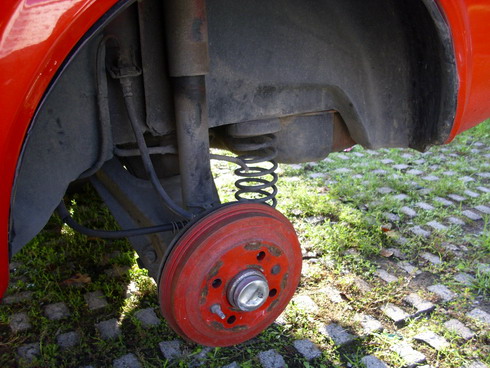
The writer of these lines and a member of the Zastava 101 Club tested all the reinforcements produced in the Felna, on the Zastava 101 35 years old and the results are really positive. Frontal bar reinforcements increase the manageability and stability of the frontal bar, all of the manufacturer's stated features are truly realistic, even exceeding expectations. The "dance" of the front track when driving off the asphalt road has been completely eliminated. The extra rear trap springs were the most surprising. They have taken on a good deal of depreciation by helping the shock absorbers very successfully. Driving comfort is significantly increased even though the rear trap is subjectively stiffer. The payload is significantly increased, so that the flag of the 101 with 5 passengers and 50 kg of cargo in the trunk no longer rests on the rubber stops, but has room for normal shock absorption from the ground, and the subjective feel of the driver is far safer as the rear ladder of the loaded car still has torsion as normal and unpleasant throbbing is completely eliminated.
In the "service of the people"…
From the moment it appeared on the market, Stojadin gained the title of prestigious, modern car, and since it was a Yugoslav product, the local public was proud to watch it. At the time, the Yugoslav Militia still had Fitz and Tristaçes in service, patrol vehicles that were outnumbered and increasingly developed traffic became less practical and susceptible to more failures. Already in 1973, the integration of the Flag 101 as an official vehicle began. Although not too fast, the Stojadin was nimble, manageable and durable, so it didn't take long to test it before it became a standard official vehicle, painted blue with a Militia sign, blue rotation in the middle of the roof rack in projection front door, with a distinctive sound signal in the production of the electronics industry Rudi Cajavec and a red sign with a stop sign "Militia" placed on the rear end of the vehicle.
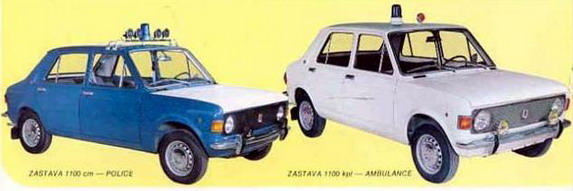
In addition to the Militia, Zastava 101 also entered the fleet of the Yugoslav National Army. Immediately it becomes a health care patron vehicle - painted white with a red cross on the door, a blue rotation and an ambulance light. It becomes the vehicle of the Customs Administration.
Socially-owned companies also wanted a practical vehicle for everyday needs, so Stojadin became the service vehicle of the Auto-Moto Federation of Yugoslavia - the famous yellow Stojadin with no rear seats in whose trunk many found help with parts and tools due to road breakdown.
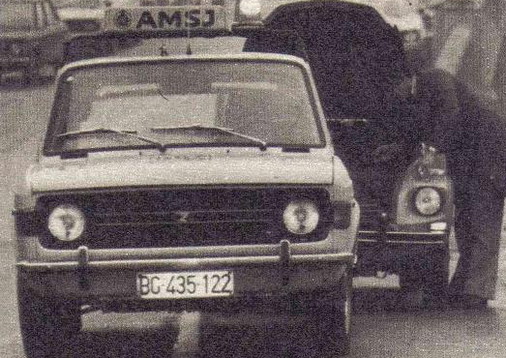
During the XNUMXs, the Belgrade city transport company had an integrated taxi service with its own fleet, painted orange with a white hood and white trunk door.
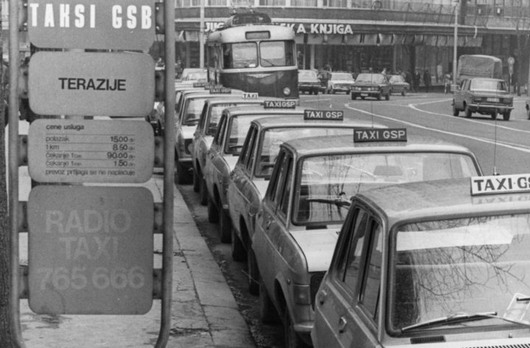
Also, Yugoslav Aerotransport used Flags 101 for service inspection of the aircraft, still photos of the repairman can be found as they inspect a Stoadin-sized aircraft engine from the platform on the roof of the car.
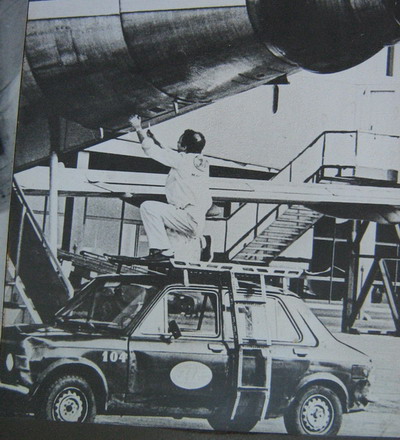
Official Stojadini companies such as: David Pajić Daka - elevators, Elektro - industrija Rade Končar with a large inscription Zanussi - Končar, Electronic Industries Niš with the logo Ei and many others could often be seen. Among the most famous driving schools was the "Red Signal", which was recognizable by Fić, and later by its Stojadins.
Although more than 40 years have passed since it appeared as an official vehicle, the trend of renewing the Zastava 101 vehicle fleet continued until the last year of production. Members of the Zastava 101 Club conducted an unofficial research throughout Serbia, which showed that this car, although out of production for 6 years, is still the most common official vehicle. It is an incredible sight in the early morning hours in the official parking lots of the Institute for Health Protection in Belgrade and the municipality of New Belgrade, where dozens of Stojadins are parked.
Interestingly, Stojadina is happy to remember most taxi drivers who claim that he was a very grateful and economical car in his time.
Cultural Impact:
From its earliest days, Flag 101 became the "ambassador" of the SFRY. It has been exported to many countries within the FIAT sales network. In parallel with everyday driving, sports competitions across Europe have introduced a new flagship vehicle as a good '' athlete ''. Particularly interesting were the titles such as' 'Flag 101 Faster Than Porsche!' 'From the 1973 Tour d' Europe, where our crews took second and third place in the overall standings. Domestic Yu rallies and races on popular trails such as Belgrade's Usce, but also expeditions such as Kragujevac-Kilimanjaro, Ararat Expedition and Roton Passe, played an important role in creating a cult of a new national class.
Seen in the global public, Stojadin also aroused interest from the media for culture from the former Yugoslavia. At the same time, Zastava 101 crews were always ready to cooperate. It is well known that members of the Kragujevac-Kilimanjaro expedition had the opportunity to present the culture of our territories throughout Africa, but also to present the culture of Africa to our public through travel texts and photographs of the written media that accompanied this expedition.
As the holder of the title "Car of the Decade" - in the seventies in Yugoslavia, Stojadin found himself in many texts of the written media, but also in the technical literature. The most famous editions of the Technical Book are "Zastava 101" by Milorad Kondić and Đorđe Ćorić, which were published until the beginning of the 1100s, following the innovations on this car. From the foreign technical literature, the service manual of the publishing house "Haynes" is known, which included Zastava's program for export to Great Britain. Also known is the Polish edition of the technical manual with the original title "Ježdže, samochodem Zastava 101P" by Zdzislav Glinka. This manual is similar to the book "Zastava 101", but in some details for everyday use and finishing of the car, it is far more detailed and precise. The Polish edition is adorned with a large number of driving tips as well as the combined tests of the Zastava 101. It is interesting that Zastava XNUMX was used as a vehicle for sketches of tests for the driving test as well as for illustrations in books for preparing the driving test from the seventies.
When we look at literary works, Zastava 101 was found in travel books. The most famous are: "Jumbo Africa" by Bogdan Shekler - a monograph on the Kragujevac-Kilimanjaro Expedition, as well as "Roadmap to the South" by Dusan Sekulic - a book that follows several expeditions in which the author participated. The monograph "Zastava, the story of one brand" by Daniel Kadarjan is the only text in which historical data on each car that came out of the production lines of the Red Flag Institute are systematized. A large number of instructions for the use of vehicles, catalogs of spare parts, brochures and advertising leaflets were issued by the end of the production from the Zastava printing house, of which the main one used to be "Nikola Nikolić" from Kragujevac. Zastava 101 found its place in foreign literature in the book "Fiat 128 (1969-1985)" written by the Italian automotive historian Alessandro Sania. The author marks Zastava 101 as "Certainly the most impressive derivative is 101, a three- or five-door fastback, which was produced in Yugoslavia under the name Zastava, which was produced under Fiat's license in parallel with Fiat 128 Berlin."
It is interesting that Stojadin was the star of many magazines, such as "Avto-magazin", "SAM", "Auto-revija", "Auto industrija". The Kragujevac-Kilimanjaro expedition was broadcast by: "Ilustrovana politika", "Večernje novosti", "Borba", "Vijesnik", "Kekec" and many others. Foreign magazines of the countries also dedicated the pages of Zastava 101 during the golden years of this car. It is interesting to note that Stojadin has not appeared in car magazines since the early 2006s, and in 55 "Auto-bild" wrote about Skala 2011, 40. "Auto-magazine" publishes an article on the occasion of 101 years since the beginning of production of Zastava 2006 The Kragujevac-Kilimanjaro expedition has not been written about since the end of the 101s, and there was not a single text on the Internet in 50 that would indicate that this expedition actually took place. Thanks to Novica Markovic, then a member of the Zastava Fan Club and one of the founders of the Zastava 101 Club, the first, amateur article was published on the Zastava Fan Club forum, which was transferred to over XNUMX different sites in the first month of publication. At about the same time, Miljan Milojković published the first version of the text on the technical development of Zastava XNUMX, which is the first systematized text on changes in this model from model development to the end of production. Both texts are included in the monograph "Flag, a story about a brand" by Daniel Kadarjan.
During 2010, the publishing house for collectors of car models "De Agostini" placed the magazine "Cult Cars of PRL" in Poland, where in one of the issues the Zastava 1100 P with a model in the scale of 1:43 was presented. According to unofficial research by members of the Polish FSO forum, the best-selling models were those made by FSO, Fiat 125, 126, but among them the Zastava 1100 P. Interestingly, this model reached our premises through sales on Ebay and Amazon. At the end of 2012, with the great efforts of Danilo Petrović, a member of the Zastava 101 Club in southern Serbia, an experimental edition of the magazine "Kultni automobili" was published, where Zastava 101 with a model was presented in the first issue. According to an unofficial research by the members of Zastava 101 Club, the entire circulation was sold out in 48 hours. Considering the fact that the magazine was not sold in the cities north of Kragujevac, and that "De Agostini" did not announce a new circulation for the rest of Serbia, the sale of this magazine was recorded through the Limndo and Kupindo portals at almost ten times the price. Only at the end of 2013, a new circulation was launched under the title "Legendary Cars", where the Zastava 101 became the best-selling model. According to unofficial research by Zastava 101 Club, most kiosks in Belgrade and Novi Sad were left without the first number in the first 48 hours after the start of sales.
The popularity of this model is also reflected in the music tracks dedicated to it. The most famous songs are '' 101 times with you on the way '' - lyrics written by Ljubivoje Ršumović, music composed by Zoran Simjanović; '' Stojadin '' of the 'Cold Beer' group; '' The Red Flag '' performed by the duo Zivka and Caslav Djokovic.
He also played roles on film. There was a dedicated movie about testing the 101 flag that cannot be reached, the film '' Kragujevac - Kilimanjaro '' directed by Branko Baletic, which is preserved in the archive of Yugoslav cinema, thanks to the enthusiasm and persistence of Novica Markovic with great cooperation with Branko Baletic, Zoran Simjanovic and Milan Rakocevic (organizer of the BC Expedition). Of the feature films, Flag 101 appears at the forefront of many domestic as well as Polish films. Of the locals, the most famous are '' Zika's Dynasty - What a Grandpa, Such a Grandson '', '' A Radio Whirlwind Calling Angel '', '' Special Education '', '' The Beauty of Marriage '' and many others.
Modeling has always been a popular hobby. Since it appeared on newsstands, the Zastava 101 model has become a real hit among enthusiasts and has introduced affordable modeling in the automotive world. Pictures of "haircut" models of Zastava 101, replicas of former stars of the rally competition, appeared on various forums. Miniature stickers, repainting, replacement of seats and interior parts, as well as the inevitable replacement of wheels, are the hallmarks of small works of art that are created every day. Due to the fact that the only available model of Zastava 101 is the base model from 1977, the production of replicas of different models of Stojadin from different periods began. Thus, by combining different parts, replicas of the Confort, Special, Mediteran models were created, early models with a "honeycomb" mask, and replicas of Skala 55 are slowly being created, for the production of which the Zastava 128 model is awaited, which will be on newsstands in the coming period. Individuals such as Danijel Dokić from Zastava 101 Club have already acquired Zastava 128, which was released in Croatia and are now working on two models at the same time: parts from Osmica create Skala 55, while parts from the older generation of Zastava 101, with additional modifications be used to make the model of the first series of FIAT 128. The Zastava 101 Club is currently competing in the production of a model of the Zastava 101, which will most closely resemble the real car of its owner.
Inspired by Zastava 101, Mladen Miljanović, an artist from Banja Luka, opened an exhibition in 2010 at the Museum of Folk Art in Vienna, where he presented Zastava 101 through modern art. The exhibition about Zastava 101 attracted a large number of visitors, and the artist who drove the visitors of the exhibition around Vienna with Zastava 101 won the "Henkel Art Award".
Stojadin, as one of the symbols of Yugoslavia, next to the legendary Fica, is the most popular car among Yugoslav nostalgics. Thus, the magazines about Zastava 101 were found at the exhibitions "Long Live Life" as well as during the exhibition "Technique to the People" in the Museum of the History of Yugoslavia.
The end of the Flag and the beginning of the legend
Unofficial data from the Flag indicate that in the early 101s, production of the Flag 101 was planned to be halted so that Florida production could increase, however, the difficult situation in the country caused the demand for Stojadin, as a cheaper solution, to grow even though the car was almost finished in the media. he didn't even mention it. Thus, the Flag 37 remained in production for XNUMX years.
As part of everyday life, the Flag 101 remains remembered as a car that didn't need to be over-advertised. Four Slovenian Television commercials have been saved and new, forgotten brochures and flyers appear on the internet every day. It is interesting to note that Zastava 4 has not been exhibited at the Belgrade Motor Show since the late 101s, and that its last appearance at the 2008 fair caused a sensation that no one from the Flag expected. The appearance of Zastava 101 at the 2008 fair was largely due to Miroslav Pacic, editor of the Zastava Nacional website, an honorary member of the Zastava 101 Club, who returned the Kragujevac Flag to the pages of European auto magazines in 2007 and 2008. Although the fair featured modern specimens of the Flag 10, Florida In Diesel and many other innovations, the oldest concept, the symbolically innovated Zastava Scala 55, began to create a large crowd around it in the early days, and the fair model was sold on the first day of the fair.
The history of the Kragujevac Flag is symbolically linked to Stojadin: the most modern car of its class, the first hatchback in Europe after the Simka 1100 TL, the first car with front-wheel drive in our country, on the other the first car that came off the production line of the new factory, the first car that In 1999 it emerged from the production line of a factory almost destroyed in a NATO bombing, and in 2008 it was the last Zastava brand car to come off the production line. The flag 101 was manufactured in the most specimens of all models manufactured in the flag and remained the longest in production. It is interesting to note that the Zastava 101 T Poly is still produced, in small batches, on the tapes of the Zastava Special Cars factory in Sombor.
The legend of the Flag 101 has always existed and the stories are endless about adventures behind the wheel of this car. The story of a gentleman traveling the flag of 101 to Oman - 3.000 kilometers in one direction - was recorded on You tube. Since 2006, the interest of the younger generation of drivers for this model has been gradually increasing. The first fan clubs were created, then the Zastava 101 Club. A 2000 newspaper article revealed that Zastava was preparing a museum exhibit that consisted of more important models that came off the production line. At one point, it was unofficially confirmed that the cars existed and were inside the factory, mostly in semi-repaired condition. The following are preserved from Zastava 101: A prototype from 1969-styled as Stojadins from the Kragujevac-Kilimanjaro expedition, the first Zastava 101 to come off the production line with serial number 00001, Zastava 101 Rally - a spare vehicle intended for Jovica Paliković during the Tour d'Europe, Zastava 101 Lux - the millionth vehicle Zastava. Thanks to the persistence of Siniša Bosanac, a member of the Zastava 101 Club, all vehicles in the museum exhibit, including the Zastava 101, were placed under state protection as a cultural and historical heritage.
According to a 2009 study by the Italian magazine Routeclassiche, the Zastava 101 has found an important place in the history of the Fiat 128. The Fiat 128 is at an ever-increasing price in Italy, in 1995 the average price of the first series was equivalent to 500 euros. 2009 euros, and according to experts, in 2000 the price will exceed 2015 euros. Although of more modest potential, Stojadin will follow the Italian trend of rising prices. Although it is the cheapest used car that can be bought on the domestic market, it can already be seen in domestic ads that the early series of Zastava 2500 in excellent condition can be bought for as little as 101 euros, with a tendency to increase the price depending on the model. Although it is impossible to calculate the exact price, according to the historians of Zastava 1500 Club, the highest prices will be achieved by rare series such as the standard model from the first series of Zastava 101 from 101 (models with chassis number below 1971), then Zastava 10 Special from 000, Zastava 101 Super - series 1979 - 101, Flag 1977 Mediterranean 1979 from series until 101, Flag 1300 Mediterranean 1980 until 101, Flag 1100 Lux series 1980-101. In a special category are collector's items such as the original Zastava 1975 Rally models with embossed "Zastava sport" on the engine and chassis, Zastava 1977 Super-Lux - the original sports model performed by the Warsaw FSO, the original export models for the French market Nogaro and Contact, as well as models exported to the UK with all the original specifics.
Although our automotive public still has a divided opinion about Stojadin, all the historical events speak of the Zastava 101 as an innovative, successful, not the best car, but a car with a time capsule in its appearance: the memories and events that many generations from a time remember long ago and which can never be returned.
Text author: Novica Markovic - Flag 101 Club
Photos: Novica Markovic, Divisions Red Flag, SAM Magazine, Danijel Dokic, forum oldtajmeri.rs
Retrieved from: auto.blog.rs
Recommendation of similar texts:

Hi there, I am Mladen and I am an auto enthusiast. I started this blog years ago to help like minded people share information about latest cars, car servicing ideas, used car info, exotic cars, and auto technology. You will find helpful articles and videos on a wide variety of cars - Audi, Mercedes, Toyota, Porsche, Volvo, BMW and much more. Ping us if you have anything cool to share on latest cars or on how to make older cars more efficient, or just want to say hi!

